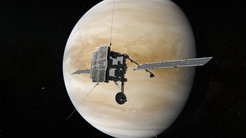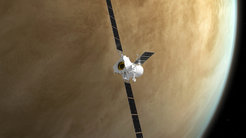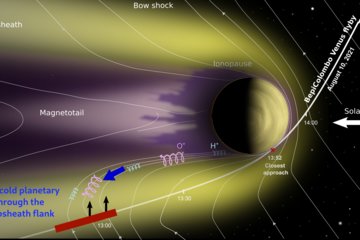Venus: Flybys by the Double
Busy times for Venus: within one day of each other, the space missions Solar Orbiter and BepiColombo are scheduled to pass closely by the planet.
Venus will be a popular “waypoint” in the next days: while advancing more and more into the inner Solar System, two space missions will pay a short visit to our neighboring planet. On Monday, August 9, the flyby will allow ESA’s Solar Orbiter to enter into a new orbit around the Sun; just one day later, BepiColombo, a joint mission of ESA and JAXA to Mercury, will fly a similar maneuver before it embarks on the last part of its journey to the innermost planet. From a scientific point of view, both mission will soar by Venus in a state of half-sleep, so to speak: while some instruments are switched off for their own protection, those that can measure particles and magnetic fields in Venus' environment will collect valuable data. Among them are instruments to which scientists and engineers from the Max Planck Institute for Solar System Research (MPS) in Germany have contributed.

Solar Orbiter will be the first of both missions to reach Venus. At approximately 6.42 a.m. (CEST) on Monday, August 9th, the probe will speed by within a distance of just under 8000 kilometers. The trajectory of the European-Japanese mission BepiColombo specifies a significantly smaller distance to Venus: at about 3:58 p.m. (CEST) on Tuesday, August 10th, it will be within approximately 550 kilometers of the planet.
For both missions, this will be the second encounter with Venus. Since some of the scientific instruments on board are more powerful than those of previous visitors to Venus, this flyby again offers a welcome opportunity to take a very close look. The fact that both probes are passing our neighboring planet in close succession is especially lucky: this allows simultaneous measurements at two different locations near Venus. This can help, for example, to understand how particles and magnetic fields propagate in this environment.
Diving into the ionosphere
Unlike Earth and Mercury, Venus does not have a strong, stable magnetic field. However, the solar wind, the fluctuating flow of charged particles from the Sun, induces electric currents in the Venusian ionosphere, creating a weak, also fluctuating magnetic field. In addition, the current of solar particles deforms Venus’ particle envelope in such a way that, on the side facing away from the Sun, it protrudes into space like a tail, sometimes spanning many millions of kilometers.
Solar Orbiter and BepiColombo intend to study these complex processes in Venus' environment during the flyby. The Mercury probe will even dive into the lower ionosphere; its instruments SERENA (Search for Exospheric Refilling and Emitted Natural Abundance), SIXS (Solar Intensity X-ray and particle Spectrometer), MPO-MAG (Mercury Planetary Orbiter Magnetometer) and MPPE (Mercury Plasma Particle Experiment) will be collecting data.

The particles and magnetic fields surrounding the inner planets Mercury, Venus, Earth, and Mars provide clues as to why they have evolved so differently since their formation. While our home planet is surrounded by a water-rich atmosphere, Mars became an arid desert planet with only remnants of an atmosphere. And Venus hides under a dense, toxic atmosphere that is responsible for a dramatic greenhouse effect. Researchers are therefore interested in the processes by which particles escape from the lower atmosphere of the respective planets into their ionosphere and from there into space.
In the data from MPPE, for example, researchers hope to find evidence of unbound carbon ions, so-called atomic carbon. Its existence in the ionosphere would suggest that not only ultraviolet light splits individual molecules in the underlying atmosphere, creating conditions for them to escape into space, but that violent collisions with electrons may also be at work. In 1996, the Solar and Heliospheric Observatory (SOHO) was able to detect atomic carbon from a distance of about 40 million kilometers in the then unusually long ion tail of Venus; since then, no other probe has succeeded in doing so.
And last but not least, the upcoming flyby is an important rehearsal for BepiColombo. Before the probe enters orbit around Mercury at the end of 2025, its itinerary includes several Mercury flybys. The upcoming activities at Venus thus provide an opportunity to ensure that all scientific instruments are in top shape by then.
About the missions
The double spacecraft BepiColombo of the European and Japanese space agencies ESA and JAXA was launched into space on October 20, 2018. It consists of two probes, the Mercury Planetary Orbiter and the Mercury Magnetospheric Orbiter, flying stacked on top of each other during the journey to Mercury. MPS has contributed hardware to the instruments BELA (BepiColombo Laser Altimeter), MIXS (Mercury Imaging X-ray Spectrometer), MPPE (Mercury Plasma Particle Experiment), and SERENA (Search for Exospheric Refilling and Emitted Natural Abundances Experiment) and is scientifically involved in the magnetometer MPO-MAG and the instrument MDM (Mercury Dust Monitor).
ESA's Solar Orbiter spacecraft has been in space since February 10, 2020. It will continue to approach the Sun on ellipses over the next few years until only 42 million kilometers separate them. MPS has contributed to the instruments PHI (Polarimetric and Helioseismic Imager), EUI (Extreme-Ultraviolet Imager), and SPICE (Spectral Imaging oft he Coronal Environment) as well as the coronagraph Metis. As remote sensing instruments, they will be switched off during the Venus flyby.













